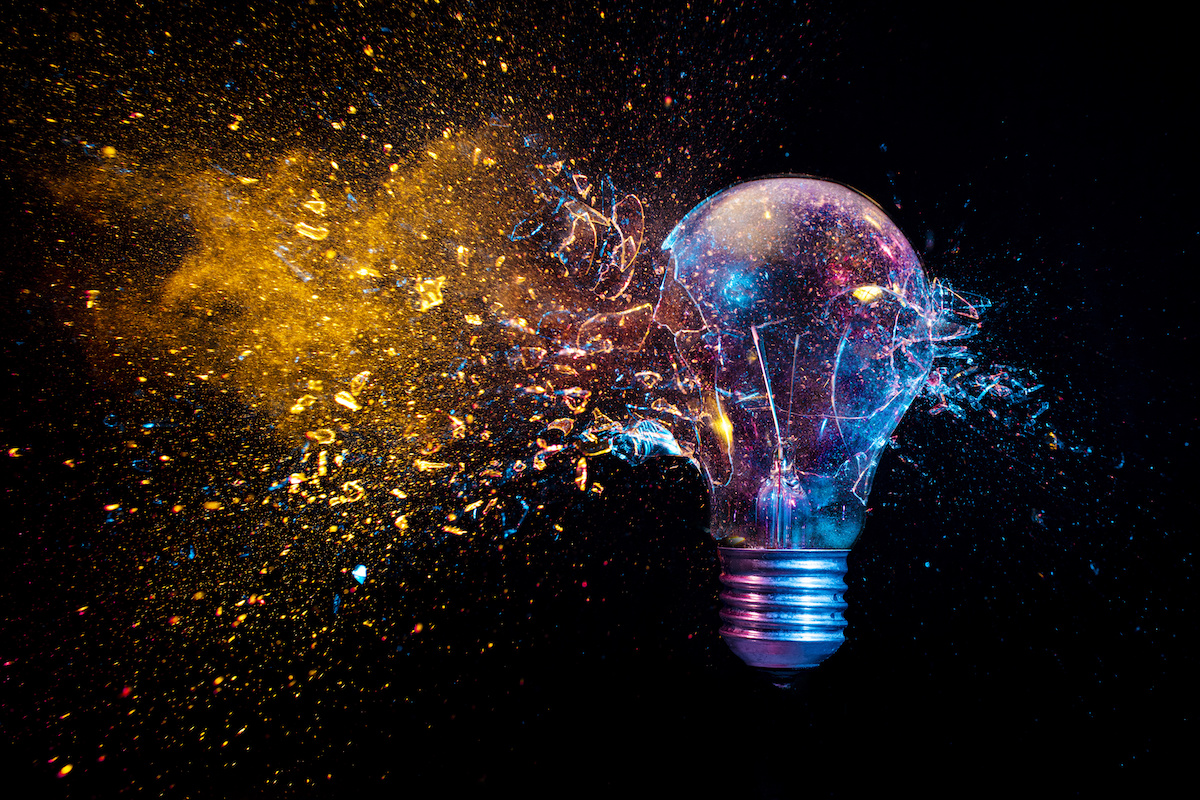Why our instincts about innovation and change work against us

- In their new book, The Human Element, authors Loran Nordgren and David Schonthal use insights from psychology and entrepreneurship to explore how innovators can best overcome opposition to change.
- In this excerpt, Nordgren and Schonthal overview the concept of “Fuel,” which they define as the force that heightens the appeal of an idea and incites our desire to change.
- To become widely adopted, innovations require Fuel. However, Nordgren and Schonthal argue that Fuel has a few key limitations that innovators should be aware of.
The principle thesis of our new book, The Human Element, is that people think in “Fuel.” In this excerpt from the book, we describe the concept and talk about the limitations of having a Fuel-based mindset.
Putting new ideas into motion
Most marketers, innovators, executives, activists, or anyone else in the business of creating change, operate on a deep assumption. It’s a view of the world so deeply ingrained in our thinking that we rarely see its influence or question its value. It is the belief that the best (and perhaps only) way to convince people to embrace a new idea is to heighten the appeal of the idea itself. We instinctively believe that if we add enough value, people will say “yes.” This reflex leads us down a path of adding features and benefits to the idea or increasing the sizzle of the messaging – all in the hope of propelling people to get on board.
We refer to strategies designed to give an idea thrust as “Fuel.” Fuel is what heightens the appeal of an idea and incites our desire to change. The job of Fuel is to enlighten the intended audience on all of the positive attributes and benefits associated with the “new way.” The need for Fuel is so well established that we have built entire industries around generating it (advertising, public relations and product design, to name a few). While Fuel may be necessary for an innovation to take hold, it has critical limitations. Understanding these limitations is the first step to breaking out of a Fuel-based mindset.
Limitation # 1: Bad is stronger than good
A doctor asks, “I have good news and bad news: which do you want to hear first?” What would you say? A majority of people (78% in a recent study) pick the bad news. This is because, for the human mind, bad is stronger than good. If you’ve ever gone through a performance review, you’ll know what we are talking about. One negative comment can instantly wash away all the positive observations that preceded it. Psychologists call this the negativity bias.
Our bias for bad affects how we see almost everything. We remember negative events more intensely than positive events. We process negative information faster than positive information. People are quick to spot an angry face in a crowd, but are much slower to find a smile. This is because the amygdala, the region of the brain responsible for recognizing facial emotion, devotes considerably more neurons to processing danger. A threatening image can trigger our fight or flight response in milliseconds, but positive events produce much slower reactions. You can jump back from a snake much faster than you can jump toward your favorite snack.
When people hesitate to embrace a new idea, there are two broad explanations. Either the idea lacks appeal (insufficient Fuel), or a Friction is blocking progress. Negativity bias has a clear implication – focus on the Frictions. This shift in mindset can be seen in Bob Sutton’s wonderful book, The No Asshole Rule, which tackles a problem that plagues many companies: low workplace morale. The conventional response to a disengaged workforce is to – this will sound familiar – add benefits. Crank up the positive in hopes of drowning out the bad. What Sutton proposes instead is fearless intolerance for bad people and bad behavior. The Negativity bias leads to the realization that benefits and perks will rarely overcome a toxic culture.
The parallels with innovation are striking. When we sell an idea, our focus is on the benefits the idea offers. We implicitly ask ourselves, “How will we seduce people into saying yes?” And when our message is ignored or outright rejected, our response is to crank up the perks. Fuel is important, of course. But Fuel isn’t the mind’s first priority.
Limitation # 2: Fuel is costly
Fuel can propel an idea and do so powerfully. But there’s a catch: Fuel is costly. Let’s take Fuel’s most common currency, money. Money moves people. And innovators often use it to get people to embrace change. Black Friday – where American shoppers wait in lines for hours to get deeply discounted goods – illustrates the influence of money quite well. But it comes at a cost.
Like shoppers, employees respond to money. But it takes a lot of money to move the needle. One recent study asked the simple question: how much of an increase in base salary does one need to improve performance? For the average employee, it was about 8 percent. Paying anything less than that did nothing. This means that if someone makes $150,000 a year, you need to promise them at least a $12,000 bonus to see an uptick in performance. Findings like this led the Behavioral Economist Ury Gneezy to conclude, when it comes to incentives, “either pay a lot or don’t pay at all.”
Limitation # 3: Fuel is often self-evident
Many good ideas are self-evident. The value is there on the surface, for everyone to see. Take the military. A stint in the military has a number of obvious and psychologically powerful benefits. The military provides excitement. It’s a chance to see the world, experience new cultures, and go on daring missions. The military offers camaraderie. People describe the service as joining a family. The military is a membership into a life-long community. People don’t just want to be part of a community. They want to be respected by that community. And the military immediately gives you that, too. We honor and recognize those who serve. The military also gives purpose. People want to see how their lives contribute to something bigger. Patriotism gives you that. And finally, there are big financial incentives. Serving in the military is many people’s path to college and upward mobility.
Does this description of the many benefits military life has to offer tell you anything you didn’t already know? We suspect not. The value proposition of joining the military isn’t hidden. Through cultural osmosis, American citizens learn about the benefits and opportunities that come with joining the military.
The US Army relies heavily on TV ads to Fuel recruitment. The ads use powerful imagery to bring all the value of the military to life. One ad opens with a soldier on a daring mission with his Special Forces team (excitement and camaraderie). We then see that same soldier coming home to be honored in his hometown parade (respect and patriotism). Finally, the commercial ends with the now former solider applying the technical skills he learned in the military to a high paying career.
It turns out (according to recruiters we’ve spoken with), a lot of kids that dream of joining the military never do because a powerful set of Emotional Frictions holds them back. One reason many would-be soldiers never enlist is because… they are afraid to tell mom. They don’t know how to start the conversation. They are afraid she will be beyond upset at the thought of her child going off to war. Despite all the value that Fuels the idea of enlisting, many just can’t overcome the emotional hurdle. Notice how ineffective these TV spots are for these would-be recruits. It is telling them what they already know without solving the problem they really have.
Most good ideas have obvious benefits. When people aren’t receptive to our message, our instinct is to highlight the benefits or find ways on the margins to sweeten the deal. This approach would make sense if the benefits needed to be discovered, but they often don’t.
Limitation # 4: Fuel amplifies friction
In the physical world, applying force to an object has an opposite and equal effect – it increases Friction. The same is true of ideas. Applying Fuel can, quite unintentionally, amplify resistance to the idea.
A former student of ours worked at a large environmental non-profit. The organization had just brought in a new CEO with bold ambitions. Although he inherited an experienced workforce – many employees had been with the organization for their entire career – he feared many had grown complacent. He wanted his team to “live the mission” and he didn’t see that commitment from them. So to boost engagement, he created a bold initiative: the 20-for-20 campaign. The goal was to raise 20 million dollars in 2020. This was a lofty goal. 2017 had been their best ever year, raising a little over 17 million. But much of that was due to a once-in-a-lifetime gift. They had raised just 14 million in 2019, so 20-for-20 was truly ambitious.
The CEO kicked-off the campaign with a celebration. He spoke about his dedication to the mission. Employees were brought on stage to share their success stories and receive applause and accolades. A retired farmer gave an emotional speech about how, without the help of the non-profit, the community would have been damaged beyond repair. And then, to close out the celebration, came the big reveal: the CEO challenged them to hit the 20 million mark in the upcoming year. His closing line was reportedly, “I am blessed to work with such an amazing group of people. You have done so much for this cause. But I believe we can all do better. We’ve seen tonight how our cause matters – there are literally lives on the line. So I ask you all to commit to the 20-in-20 challenge – raising 20 million dollars in the next year. I believe you can do it. I know you can do it.” That year, they raised just 12 million dollars, two million less than the previous year. And they recorded their highest rate of turnover in memory.
The 20-in-20 challenge was meant to give employees the added Fuel they needed to achieve new fundraising heights. Instead, the initiative created strong Emotional Friction. It backfired, we suspect, because employees didn’t believe the goal was realistic. They were trying their very best already. And now they were being asked to do even more with the same amount of resources. The CEO was saying, “I believe in you.” But what they heard was “This guy doesn’t think we are trying hard enough.” They left the celebration feeling insulted, not energized.
These examples illustrate another important consequence of not accounting for Friction. It isn’t just that the idea that suffers. The innovator suffers too. The CEO invested heavily in his vision, and put his reputation on the line, only to watch it fail. What does the CEO learn from this experience? Many learn to lose faith in those around them. They learn the “it’s impossible to get anything done around here” mentality. Frictions are usually hidden from plain sight. If we don’t understand the forces of resistance, we end up placing the blame on the people and institutions that reject our ideas and not the dark forces that undermine them.
The Human Element by Loran Nordgren and David Schonthal, published by Wiley, is available here.




